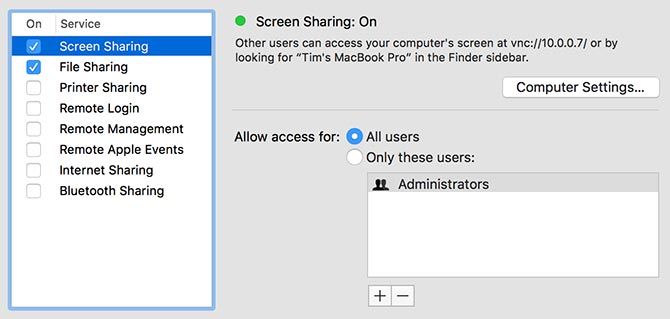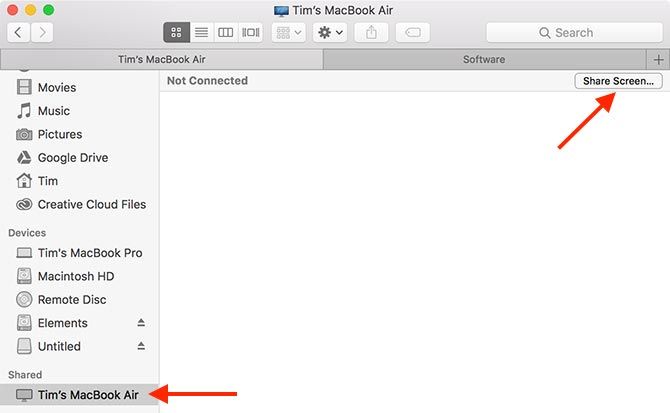How to Remote Access Your Mac
Posted by TIM BROOKES

Did you know you can connect to your Mac remotely over a local network, or the wider internet? You don’t need expensive software like Apple Remote Desktop to do this, since so many great free options exist.
You can use your Windows PC, iPhone or iPad, and even Android smartphone to perform remote tasks on a Mac at home or in the office. All you need is a solid network connection and the right tools.
Remote Access Your Mac From Another Mac
The easiest way to access your Mac remotely is from another Mac via the wonders of iCloud. This also works great over a local network, which is ideal if you’re using an old Mac as a fileserver and don’t have it connected to a monitor.
The feature is called Back to My Mac, which uses your Apple ID to tie all your Mac hardware together. You don’t even need to be logged in, provided the computer is powered on.
To set up Back to My Mac and make your computers accessible:
- Head to System Preferences > iCloud and make sure you’re logged in with your Apple ID.
- In the same menu, enable Back to My Mac toward the bottom of the list.
- Head to System Preferences > Sharing and make sure Screen Sharing is checked.

Do this for every Apple computer in your house, at your office, or anywhere else you’d like to remotely connect to. In order to connect from another Mac:
- Make sure you’re logged into the same Apple ID under System Preferences > iCloud.
- Open a Finder window and look in the sidebar for the Shared section.
- Click on the Mac you want to connect to, then click Share Screen in the top-right corner of the window.

You’ll then connect to your Mac either over the local network or via the internet. If you can’t see the sidebar, click View > Show Sidebar in Finder. And if you can’t see the Shared section, head to Finder > Preferences > Sidebar and enable Back to My Mac under Shared.
Remote Access Your Mac From a Windows PC
The easiest way to remotely access your Mac from a Windows PC is using an app like TeamViewer. While TeamViewer is the choice we recommend using, you have many screen sharing and remote access tools to choose from.
TeamViewer has many benefits: it’s free for personal use, available on many different platforms, and generally has excellent performance. Ultimately, performance of any remote access solution will hinge on the speed of your internet connection and the distance between the two computers.
To make your Mac accessible via TeamViewer:
- Sign up for a TeamViewer account, then download and install TeamViewer for Mac.
- Run the app and log into your TeamViewer account.
- Look for the Unattended Access heading and click each of the three checks in order to make your Mac available even when you’re not using it.

In order to connect to your Mac from a Windows PC, download and install TeamViewer for Windows. Log in and look for your Mac under the My computers section. Double-click on your Mac and wait. You should soon see your Mac screen in a window on your PC desktop, with full control.
The first time you log in to TeamViewer on your Windows PC, you’ll need to verify it by clicking a link in your email.
Remote Access Your Mac From an iPhone, iPad, or Android Device
Remotely accessing your Mac from a mobile device running iOS (iPhone, iPad) or Android is also possible using TeamViewer. The most important step is making your Mac available while unattended, so you can gain access whenever you want.
In order to do this, make sure you’ve run through the first part of the Windows tutorial above. Once you’ve installed TeamViewer on your Mac, logged in, and set it up to receive incoming connections, grab the mobile app of your choice.
Either download the iOS TeamViewer app from the App Store, or the Android TeamViewer app from Google Play. Just like on Windows, the first time you log into your TeamViewer account on a mobile device, you’ll need to verify it by following a link in your email.
Download the TeamViewer mobile app, log in and verify your device, then select your Mac from the list of computers. Tap Remote Control to connect to your computer and control it remotely.
Can You Remote Control an iPhone?
So you can remote control your Mac from pretty much any device, but what about your iPhone? The short answer is no. Apple doesn’t allow you to install system-level software that would allow for remote control. Apple may argue it’s a security feature, but it’s also a symptom of the tightly controlled iOS ecosystem.
However, if you jailbreak your iPhone, you can remote it. Jailbreaking provides you with the system-level access required to install deep tweaks to iOS. It opens your iPhone up to all sorts of potential security threats, and it voids your warranty. Thus, you probably shouldn’t jailbreak your iPhone.
There are a few tasks you can do without jailbreaking your iPhone, like sending SMS messages and making phone calls via your Mac. You can also access your iOS Safari tabs from Safari for Mac, but none of these are true remote control. With that in mind, we’ve got a tutorial detailing how to remote control your jailbroken iPhone from any device.

Use Your Mac, Wherever You Are
Back to My Mac is the easiest way to get access to your Mac, but it requires another Mac to use. If you have a Windows PC or mobile device that you want to use instead, you’ll have to resort to TeamViewer. Thankfully, you can set up both of these solutions and use them at a later time.
Remote access is great, but if you want to make your Mac even smarter, you should check out Automator.
Read the full article: How to Remote Access Your Mac






